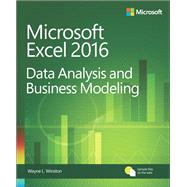Master business modeling and analysis techniques with Microsoft Excel 2016, and transform data into bottom-line results. Written by award-winning educator Wayne Winston, this hands on, scenario-focused guide helps you use Excel’s newest tools to ask the right questions and get accurate, actionable answers. This edition adds 150+ new problems with solutions, plus a chapter of basic spreadsheet models to make sure you’re fully up to speed.
Solve real business problems with Excel—and build your competitive advantage
- Quickly transition from Excel basics to sophisticated analytics
- Summarize data by using PivotTables and Descriptive Statistics
- Use Excel trend curves, multiple regression, and exponential smoothing
- Master advanced functions such as OFFSET and INDIRECT
- Delve into key financial, statistical, and time functions
- Leverage the new charts in Excel 2016 (including box and whisker and waterfall charts)
- Make charts more effective by using Power View
- Tame complex optimizations by using Excel Solver
- Run Monte Carlo simulations on stock prices and bidding models
- Work with the AGGREGATE function and table slicers
- Create PivotTables from data in different worksheets or workbooks
- Learn about basic probability and Bayes’ Theorem
- Automate repetitive tasks by using macros








